
Virtually every object (except the bright star with spikes to the upper center right) is a galaxy! However, the dominant galaxy type is small, with few spirals. (From G. Bothun, via http://www.astr.ua.edu/gifimages/coma.html)
Key points: Nature of galaxy clusters, larger scale organization of galaxies and its origins; gravitational lenses
Many galaxies are found in “groups” or “clusters.” The distinction between a group and cluster is size – a group typically contains a few tens of galaxies while clusters may have thousands of members.
 |
Picture of the core of the Coma Cluster of Galaxies: Virtually every object (except the bright star with spikes to the upper center right) is a galaxy! However, the dominant galaxy type is small, with few spirals. (From G. Bothun, via http://www.astr.ua.edu/gifimages/coma.html)
|
Galaxy clusters (at least the nearby ones) have very different
properties in their centers than hold for galaxies elsewhere. The X-ray plasma
tends to strip the gas out of the smaller galaxies and they tend to collide
often, building up one or two very massive elliptical galaxies that dominate the
cluster cores. ![]() (from J. Dubinski, http://www.cita.utoronto.ca/~dubinski/nbody/)
(from J. Dubinski, http://www.cita.utoronto.ca/~dubinski/nbody/)
The Large Scale Organization of Galaxies in Space
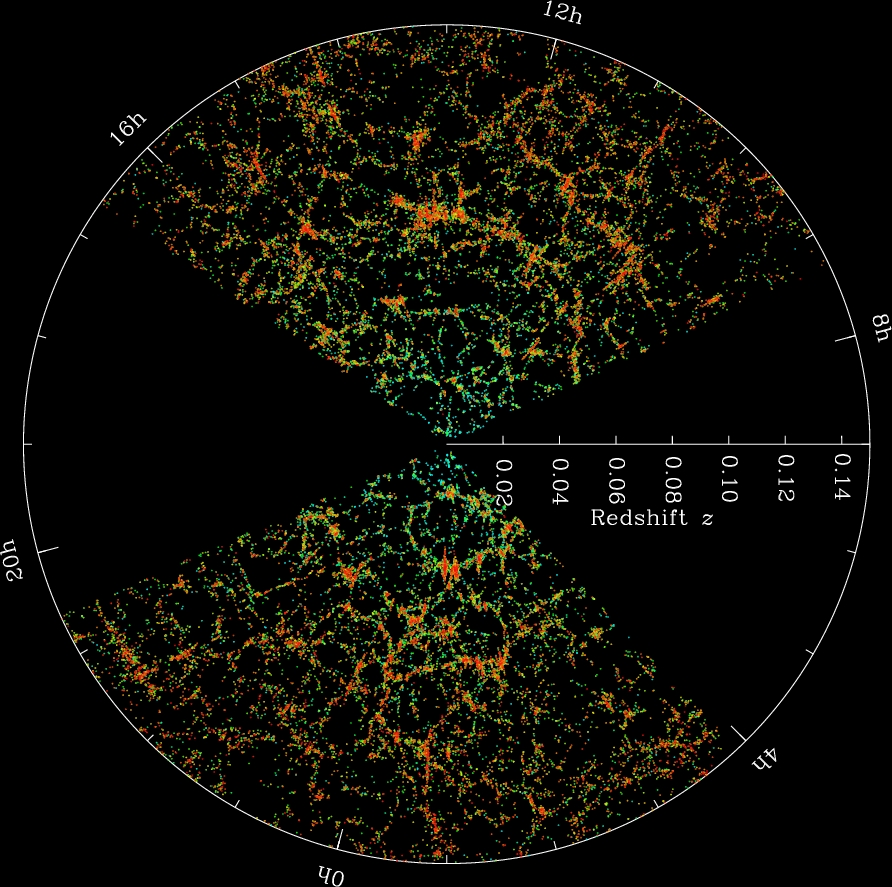 |
We can locate the nearby galaxies in three
dimensional space by estimating their distances from their redshifts, and their
positions in other directions from their location on the sky. We find that the galaxies form a soap bubble-like or "foamy" distribution in
space with galaxies lying along the surfaces of the bubbles and nothing in the centers of
the bubbles; these nearly empty regions are called "voids". Here we show the projection in distance and one direction on the
sky (the plane of the Milky Way and other restraints on the viewing blot out the
wedge shaped dark regions). (From M. Blanton, Sloan Digital Sky Survey,
http://www.sdss.org/includes/sideimages/sdss_pie2.html)
|

 |
Near the position of The Great Attractor, there is a very massive galaxy cluster -- it along with other nearby concentrations of galaxies make up the supercluster. (From APOD, 2P2 Team, WFI, MPG/ESO 2.2-m Telescope, La Silla, ESO, http://antwrp.gsfc.nasa.gov/apod/ap000104.html) |
The distribution of galaxies in large filamentary structures, with occasional massive concentrations, is exactly like the models of the early Universe. Of course, the only models that have survived are the ones for which this claim can be made, that's how science works. Nonetheless, it is encouraging that we can make models that fit the observations!
 |
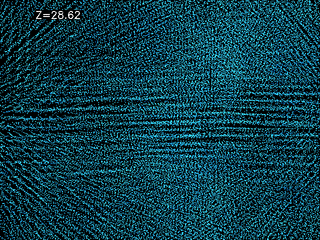 |
| These animations show the growth of structures due to the dark matter
gravity, then the first galaxies form and begin to merge as they collide with each other. |
from National Center for
Supercomputer Applications by Andrey Kravtsov (The University of Chicago) and Anatoly Klypin (New Mexico State University). http://cfcp.uchicago.edu/lss/group.html |
Massive galaxy clusters can focus the light of the Universe behind, through gravitational lensing
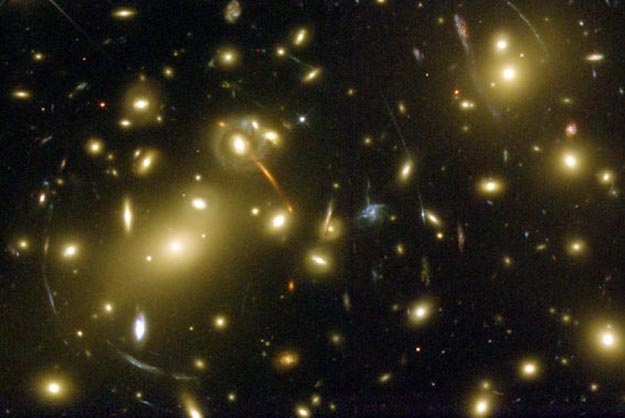 |
Picture of Abell 2218, showing "gravitational
lensing." The many arcs, centered on the biggest and most massive galaxies, are
images of very distant galaxies behind the cluster. (A. Fruchter,
HST, APOD, http://antwrp.gsfc.nasa.gov/apod/ap011007.html)
|
The lens works because the light from the background object is bent by the gravitational field of the lensing one.
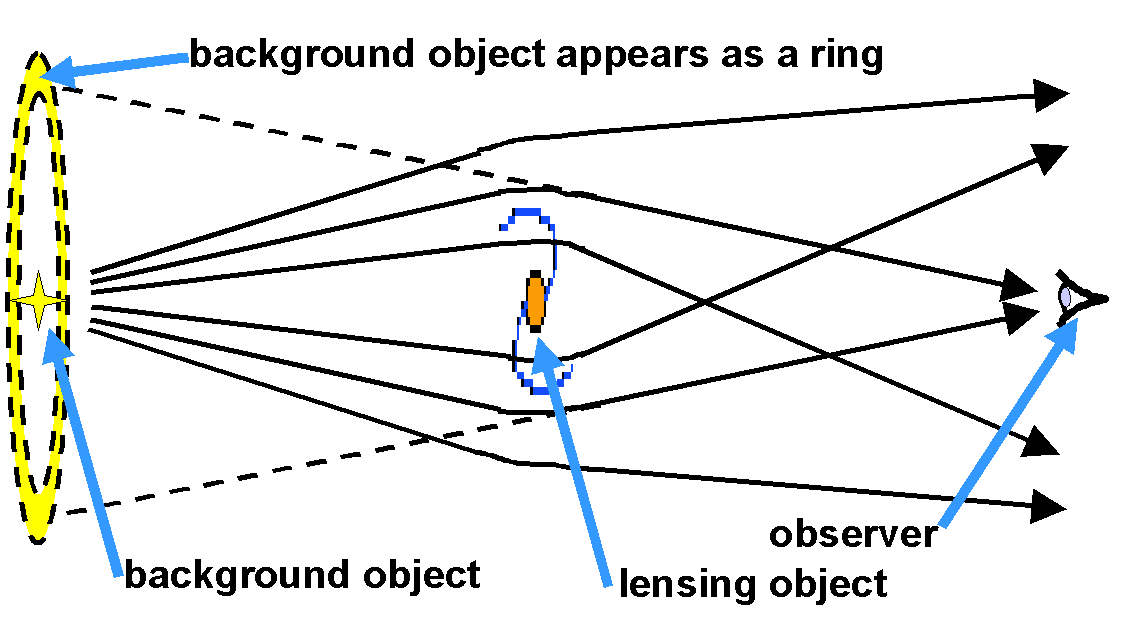 |
At just the right distance from the center of the lensing object, the bending will bring the light to us.We will think the light came from the direction indicated by the dashed lines, though. As a result, if the background object is exactly behind the lensing one, we will see a ring of lensed light. (illustration by G. Rieke) |
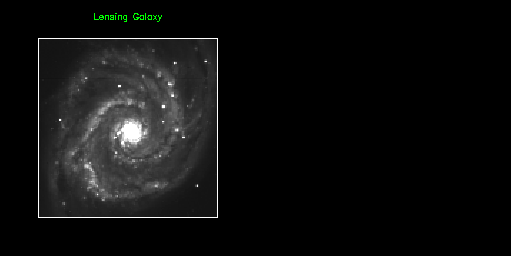 |
Here is an animation of the different forms the lensing takes. The
lensing galaxy fades and is replaced by a yellow circle. The left panel then shows how the
background object looks without lensing, and the right panel how it looks with lensing. (from
http://www.atnf.CSIRO.AU/~jlovell/simlens/) Here is a spectacular movie of the lensing of
background galaxies (blue) as they move behind a cluster of galaxies (yellow)
|
 |
 |
| Here is a "still" from the movie above, when the source is well off the axis* of the lens. There is a bright arc
image and a faint one (that might be too faint for us to detect), similar to the
arcs seen in the lensing galaxy clusters. *the axis is the line from us to the center of the lensing mass, projected back to the lensed source. |
Here is a lensed quasar (blue arc). The lensing galaxy is the red object next to it. (quasar image from STScI, http://science.nasa.gov/newhome/headlines/ast14may99_1.htm) |
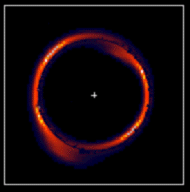 |
 |
| Here is another "still" with the source close to the axis of the lens but not quite on it. The two arcs each bend around by about 90 degrees with bright spots near their ends. The four-fold symmetry is called an "Einstein cross." | Here is a lensed quasar -- the center source is the lensing galaxy, and the four images are an Einstein cross. (K. Ratnatunga, M. Im, APOD, http://antwrp.gsfc.nasa.gov/apod/ap951220.html) |
 |
 |
| Yet another "still", this time with the lensed source exactly on axis -- we get a uniform ring image, just as we predicted above. | And here is a quasar imaged as a ring (with the lensing galaxy as the bright central spot). (L. J. King, APOD, http://antwrp.gsfc.nasa.gov/apod/ap980330.html) |
A gravitational lens may have too much distortion to use in your camera! (Plus your camera would be way too heavy to lift.)
The Smithsonian Institution to the left and as imaged with a gravitational lens to the right (computer model only -- the calculation assumed viewing from the Natural History Museum with a lens about the mass of Saturn, so no experiments were actually conducted!) (from B. McLeod, CASTLES project -- and extra thanks to Brian for the details on the mass assumed).
 |
 |
Useless as they may be for conventional snapshots, gravitational lenses allow us to probe very distant galaxies and quasars in a number of ways that would not be possible without them. For example, they boost the signal from very distant objects and can make them easier to detect at long wavelengths (far infrared, submillimeter) where our telescopes have too little resolution to see them as arcs. In this way, astronomers have shown that there are many very luminous galaxies at the same redshift as the ones we see in the Hubble Deep Field, but too red to be seen by the Hubble Telescope.
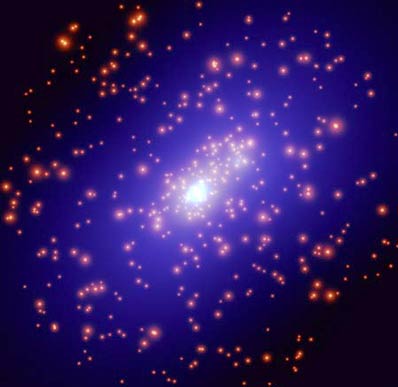 |
The lenses also show in
another way that the galaxy clusters are dominated by
dark matter. The image to the left shows how a
cluster might look if the dark matter weren't so dark, but glowed blue. The visible matter
- galaxies - is shown as red and white. The distribution of dark matter was determined
indirectly by studying graviational lensing in the cluster. (from
Spaceflight Now, July 17, 2003, plus European Space Agency, NASA and Jean-Paul Kneib (Observatoire
Midi-Pyrénées, France/Caltech, USA) This animation shows what it would be like to fly through space and around a
massive cluster like the one shown to the left. The animation shows the dark matter alone,
but since that dominates the mass it is really showing where the mass lies. It starts with
general intergalactic space, and then flies around the cluster - the total journey would
take 2.4 billion years at the speed of light. Cautious,
large file!
|
Test your understanding before going on![]()
|
"Dark Matter" by G. Rieke |
|
Ultraviolet view of M81 enhances spiral arms, from APOD, NASA, UIT: http://antwrp.gsfc.nasa.gov/apod/ap960713.html |
Click to return to syllabus |
||
| Click to return to Dark Matter | hypertext |
Click to go to Spiral Arms |